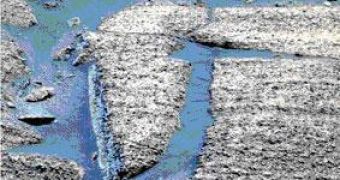MER-B (Mars Exploration Rover - B), known as Opportunity, is the second of the two rovers of NASA's Mars Exploration Rover Mission. It landed successfully at Meridiani Planum on Mars on January 25, 2004, and since then, has sent many interesting pictures of the Martian surface.
Some of the most recent pictures sent back to Earth showed a real curiosity. After analyzing them, an official report identified spots that appear to have contained liquid water two years ago, at a time when the Rover was exploring a crater called Endurance.
This is probably the most important recent controversial issue regarding Mars, as most scientists are convinced that liquid water cannot exist on the surface of Mars today because of the planet's thin atmosphere. So far, their existence has not been officially confirmed.
It there were really ponds of liquid water on the surface of Mars, that would mean an increased probability that living organisms could survive on or near the surface of Mars, says physicist Ron Levin, the report's lead author, who works in advanced image processing at the aerospace company Lockheed Martin in Arizona.
Levin and his colleague, engineer Daniel Lyddy, reconstructed stereoscopic images by superimposing images from the Opportunity rover's twin cameras and the resulting pictures show blue features that look perfectly flat, so smooth that the software could not match any surface details in those areas between the two images.
The lowest parts of the terrain, these areas appear transparent, showing what seem to be submerged rocks or pebbles. There could be at least two explanations for this: thin ice or liquid ice. The latter would be a cosmic revolution, and would represent the first liquid water ever discovered on Mars.
"The surface is incredibly smooth, and the edges are in a plane and all at the same altitude," Levin says. "If they were ice or some other material, they'd show wear and tear over the surface, there would be rubble or sand or something."

 14 DAY TRIAL //
14 DAY TRIAL //